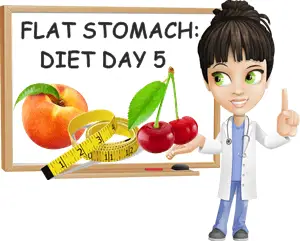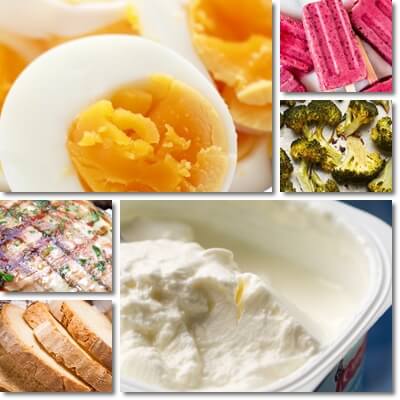Do you want a flat stomach? Then the first step to undertake is to lose excess weight. It’s only below a certain body fat percentage that you get to have a flat stomach. And the only real way to lose body fat is to go on a diet and slowly and steadily lose the excess weight.
But for a weight loss diet to be sustainable long-term, eating must be balanced and provide satiety.
A great way to make sure you feel fed and satisfied is to balance your macronutrients, that is, make sure you eat carbohydrates, fat and protein at the same meal. While fad diets are absolutely against getting all of your macros at the same meal, much less eating things like rice or bread, know that you can successfully lose weight without excluding all manner of carbs from your diet. I’ve done it and went from being overweight to reaching the lower limit of my normal weight, all the while eating everything from white rice and whole grain pasta to fresh fruit, milk and meat.

Today I’m going to share with you my day 5 weight loss meal plan, with tried and tested recipes I’ve been eating throughout my weight loss journey. For more inspiration on what to eat to lose weight and get a flat stomach, also see my day 1, day 2, day 3 and day 4 meal plans.
Do mix and match the proposed meal plan dishes so that you feel comfortable with what you eat. Find alternatives to ingredients you cannot or simply do not want to eat, so long as the substitutions are in the same calorie range. Just remember to stick to the amounts provided so that you do not go over a certain daily intake of calories. And have your protein, fat and carbs so you don’t feel hunger.
Breakfast: whole milk plain unsweetened Greek yogurt, cereal, fresh fruit
- Ingredients: 200 grams of plain, unsweetened, whole milk Greek yogurt, 30 grams of unsweetened corn flakes/oat flakes, roughly 100 grams of fresh fruit
- Fruit options: 100 grams red raspberries, 100 grams yellow raspberries, 100 grams black or purple raspberries, 100 grams apricots, 125 grams fresh peaches or nectarines, 100 grams orange
- Calories (average values): 200 kcal (kilocalories) from the natural yogurt, 115 kcal from corn flakes/oat flakes, 50 kcal from the fresh fruit provided as examples for a total of 365 kcal
The choice of yogurt may seem unusual for a weight loss diet because it’s whole milk yogurt. However, whole milk yogurt is an option that provides the type of nutritional properties this diet is all about.
More exactly, choosing whole milk (unsweetened) Greek yogurt, essentially a plain yogurt made from whole milk, ensures you get a healthy intake of protein and fat for macronutrient balance.
A serving of 200 grams of plain, unsweetened, whole milk Greek yogurt provides 18 grams of quality protein and 10 grams of fat (average values). The carbohydrate part of the meal is beautifully covered by both the cereal and fresh fruit (although you still get carbs and some sugars from the yogurt as well, about 8 grams total). The best part is you get both simple and complex carbohydrates from both the cereal and the fruit, including healthy amounts of dietary fiber.
The mix of protein and fat from the yogurt and carbohydrates from the cereals and fresh fruit contribute to satiety and help curb hunger and cravings. The fat, protein and complex carbs get digested more slowly which helps keep you satiated and satisfied between meals.

What are the benefits?
A meal like this provides varied nutrition and health benefits that are just as varied. The yogurt has generous amounts of vitamin B12 for a boost in vitality and energy levels, as well as vitamin B2 with benefits for the skin and nervous system. The yogurt is also an important source of calcium and phosphorus for good bone density and healthy teeth and bones.
Rich in prebiotic elements, natural yogurt actively promotes bowel health, helping feed and grow populations of good gut bacteria. Research shows that balanced gut microbiota supports the immune system, with lower risks for autoimmune conditions and inflammatory bowel disease, and contributes to achieving a healthy weight.
The cereals and fresh fruit contribute to daily fiber intakes for added benefits for bowel health, notably better transit and more regular bowel movements. Fruits also provide important antioxidants with systemic benefits, including free radical-scavenging and anti-inflammatory benefits.
Lunch: boiled eggs, green salad (lettuce, lamb’s lettuce, escarole), pink radishes, red onion, sweet potato, bread
- Ingredients: 2 medium-sized boiled eggs (62-63 grams per egg for a total of 125 grams of egg), 200 grams green salad (lettuce, lamb’s lettuce, escarole or broad-leaved endive), 100 grams pink radishes, 20 grams red onion, 125 grams baked/grilled/boiled sweet potato (weighed raw), 40 grams of bread
- Calories (average values): 180 kcal (kilocalories) from the eggs, 40 kcal from the green salad, 15 kcal from the pink radishes, 10 kcal from the onion, 110 kcal from the sweet potato, 100 kcal from the bread for a total of 455 kcal
For lunch, make a salad of all the ingredients listed and pack it for work. You can choose between sweet potato and bread for your carbohydrate part of the meal, depending on what you feel like eating that day or what you think would work better together with the rest of the foods, or have both. Do go for boiled eggs because they pack well and carry very low to no risks of foodborne illness.
As for the salad, you can choose between very low-calorie options such as regular green lettuce, lamb’s lettuce, escarole or broad-leaved endive or other chicory greens or endives you may prefer taste-wise.
The eggs account for both the protein and fat part of the meal and contribute to long-lasting satiety and satisfaction as they get digested more slowly.
The sweet potato and bread provide the bulk of the carbohydrates in the meal, both simple and complex, to satiate as well as satisfy cravings, including the craving for something sweet.
What are the benefits?
The eggs are very low glycemic foods, some say even zero-glycemic, because they are high-protein, high-fat and almost carb-free, so they lower the glycemic index score of the entire meal.
They help prevent blood sugar fluctuations and combat associated binge eating, for long-lasting energy and increased satisfaction.
The eggs themselves provide excellent nutrition – eggs are especially high in vitamin B12 for increased vitality and good energy levels. Vitamin B12 and cholesterol from eggs benefit the nervous system, while vitamin D, dietary minerals such as phosphorus and selenium help with bone density. The protein in eggs is good for muscles and supports nervous system health and the immune system function.
Orange-fleshed sweet potatoes provide antioxidants with benefits for eyesight, skin and the immune system, while red and purple-fleshed sweet potatoes provide antioxidants with scientifically proven anti-inflammatory and anticancer benefits.
The salad, pink radishes and red onion are healthy foods that add flavor and bulk to the meal, providing important amounts of dietary fiber for satiation and bowel regularity, as well as antioxidants with anti-inflammatory, free radical-scavenging and even anticancer benefits. Green salads are especially good sources of vitamin K and have good amounts of vitamin C with anti-inflammatory and anticancer properties.
Snack:
- Option no. 1: ice pop, fruit or chocolate – there are plenty of options at 150 kcal per piece (approximately 150 kcal)
- Option no. 2: 25 grams of salted crackers or crackers with herbs (these run at 480 kcal/100 grams) with 30 grams of a low calorie high protein cream cheese (approximately 250 kcal)
- Option no. 3: 15 grams of dark chocolate + 10 grams of raw or toasted almonds or sunflower seeds (approximately 150 kcal)
- Option no. 4: 230 grams of seasonal yellow cherries, red or black cherries (approximately 150 kcal)
A snack is just as important for curbing hunger as it is for curbing cravings. While you do need to limit the number of calories and go for healthy options, do eat things you like. Just make sure you stay within a reasonable intake (or number of calories) as this is not a main meal.
Dinner: chicken breast patties, baked broccoli, bread
- Ingredients: chicken patties – plain patties made from 200 grams of chicken breast meat, no skin (baked in the oven), 260 grams broccoli (baked in the oven), 50 grams bread
- Calories (average values): 260 kcal from the chicken patties, 90 kcal from the broccoli, 125 kcal from the bread for a total of 475 kcal
Observations:
For the chicken patties: season 200 grams of chicken breast meat, no skin, with salt, pepper, paprika, fresh parsley other spices or herbs you make like. Wet your hands and form patties. Place on a baking sheet and bake on both sides until done. For the broccoli, season to your liking and bake until done.
Avoid adding any oil or fat – just one tablespoon of oil will add up to 125-130 calories to your meals. You do get small amounts of fat from the chicken meat for macronutrient balance, and can successfully rely on building good flavor using spices and herbs.
What are the benefits?
The chicken breast patties are a low-calorie option to get lots of protein in, 45 grams of protein to be more exact. The protein in chicken is complete in all essential amino acids the body needs every day. Protein is needed for muscles and the nervous system, helps with satiety, mood and sleep, as well as contributes to the immune system function.
You also get 5 to 6 grams of fat per 200 grams of chicken breast meat without skin. The fat is a source of benefits for the brain and nervous system, as well as skin. The chicken patties are also a source of excellent nutrition, covering a range of essential nutrients, mainly B vitamins and dietary minerals with benefits for energy metabolism, thyroid health and bone density.
As for the carbohydrates, they come primarily from the bread, but also the broccoli. The bread helps satisfy carb cravings, and can be refined white bread or whole grain, depending on preferences. If you choose whole grain, you will upping your intake of healthy dietary minerals.
Broccoli is a source of dietary fiber and high in vitamin K with anti-inflammatory, antibleeding and anticancer properties. It also provides good amounts of B vitamins for energy metabolism and organic sulfur compounds with added anticancer effects.
